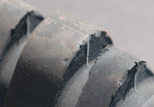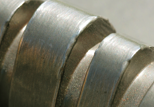De-Flashing Case Study Forged Camshafts
The Challenge

Our customer is a major automobile builder and manufactures its major engine components in-house. De-flashing and descaling of the camshafts needed to be done prior to turning. The method in use at the time was a hand operation using a coated abrasive disc on a hand grinder to knock down the parting line, followed by high pressure blasting with steel shot to remove the iron oxide scale. This system was difficult to quantify and hard to control, in addition to being very labor intensive. CDMC deburring engineers consulted with our customer and devised a highly productive and predictable solution to all their needs.
The Solution
We applied our extensive knowledge of brushes to this application, incorporating seven brush heads at five workstations to perform a complete de-flash and descaling. Our customer insisted that all the iron oxide scale be trapped and collected in a container that was safe and easy for operators to empty. A large Torit collection unit mounted to the top of the machine filtered the fine particles and separated the heavier particles into a metal container accessible from the shop floor. CDMC developed a new urethane impregnated brush core specifically for this application.
The part is first de-flashed by a massive four-head brush array fitted with the newly developed brush cores, aggressively reducing the parting line. At the next four stations a rising and falling single-head wire brush further reduces the parting line and removes the last traces of scale.
Our customer specified a very close tolerance for parting line projection, beyond which the turning tools would wear too fast. As you can see from the After part picture below, not only was the line knocked down below spec, it was virtually eliminated. The parts are rotated on the holding spindle at each brushing station to insure uniform de-flashing. An on-site robot loads and unloads parts.


